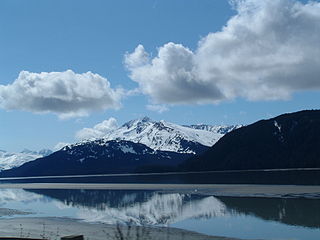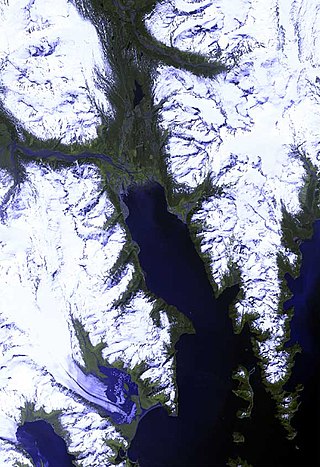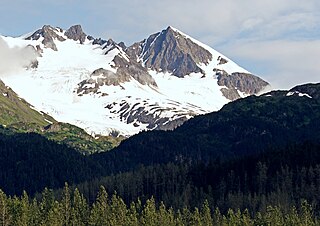
Prince William Sound is a sound off the Gulf of Alaska on the south coast of the U.S. state of Alaska. It is located on the east side of the Kenai Peninsula. Its largest port is Valdez, at the southern terminus of the Trans-Alaska Pipeline System. Other settlements on the sound, which contains numerous small islands, include Cordova and Whittier plus the Alaska native villages of Chenega and Tatitlek.

The Pacific Coast Ranges are the series of mountain ranges that stretch along the West Coast of North America from Alaska south to Northern and Central Mexico. Although they are commonly thought to be the westernmost mountain range of the continental United States and Canada, the geologically distinct Insular Mountains of Vancouver Island lie farther west.

The Kenai Peninsula is a large peninsula jutting from the coast of Southcentral Alaska. The name Kenai is derived from the word "Kenaitze" or "Kenaitze Indian Tribe", the name of the Native Athabascan Alaskan tribe, the Kahtnuht’ana Dena’ina, who historically inhabited the area. They called the Kenai Peninsula Yaghanen.

Colorado National Monument is a National Park Service unit near the city of Grand Junction, Colorado. Sheer-walled canyons cut deep into sandstone and granite–gneiss–schist rock formations. This is an area of desert land high on the Colorado Plateau, with pinyon and juniper forests on the plateau. The park hosts a wide range of wildlife, including red-tailed hawks, golden eagles, ravens, jays, desert bighorn sheep, and coyotes. Activities include hiking, horseback riding, road bicycling, and scenic drives; a visitor center on the west side contains a natural history museum and gift shop. There are scenic views from trails, Rim Rock Drive, which winds along the plateau, and the campground. Nearby are the Book Cliffs and the largest flat-topped mountain in the world, the Grand Mesa.

Kenai Fjords National Park is an American national park that comprises the Harding Icefield, its outflowing glaciers, and coastal fjords and islands. The park covers an area of 669,984 acres on the Kenai Peninsula in south-central Alaska, west of the town of Seward.

Turnagain Arm is a waterway into the northwestern part of the Gulf of Alaska. It is one of two narrow branches at the north end of Cook Inlet, the other being Knik Arm. Turnagain is subject to climate extremes and large tide ranges.
The Alaska Baseball League (ABL) is an amateur collegiate summer baseball league based entirely in southern Alaska. Players in the league must have attended one year of college and must have one year of NCAA eligibility remaining.

Glacier morphology, or the form a glacier takes, is influenced by temperature, precipitation, topography, and other factors. The goal of glacial morphology is to gain a better understanding of glaciated landscapes and the way they are shaped. Types of glaciers can range from massive ice sheets, such as the Greenland ice sheet, to small cirque glaciers found perched on mountain tops. Glaciers can be grouped into two main categories:

Exit Glacier is a glacier derived from the Harding Icefield in the Kenai Mountains of Alaska and one of Kenai Fjords National Park's major attractions. It is one of the most accessible valley glaciers in Alaska and is a visible indicator of glacial recession due to climate change. Exit Glacier retreated approximately 187 feet (57 m) from 2013 to 2014 and park scientists continue to monitor and record the glacier's accelerating recession.

Viad Corp provides experiential leisure travel and face-to-face events in the United States, Canada, the United Kingdom, Europe, and the United Arab Emirates via two divisions: GES and Pursuit.

The Aialik Glacier is a glacier in the Kenai Peninsula Borough of Alaska. It drains into Aialik Bay. Part of Kenai Fjords National Park, it drains the Harding Icefield. Aialik Glacier, a little over 15 miles from Seward, is the largest glacier in Aialik Bay, located in Kenai Fjords National Park. While fairly stable, the glacier calves most actively in May and June.

Holgate Glacier is a glacier located in the U.S. state of Alaska, in Kenai Fjords National Park. It flows outward from the Harding Icefield toward Holgate Arm of Aialik Bay. Tour boats from Seward, Alaska offer tourists the opportunity to view the glacier.

Caines Head State Recreation Area is a 6,571-acre (26.59 km2) recreational area encompassing the Caines Head cape in Resurrection Bay, Alaska. The area is located in the Kenai Peninsula Borough, 7 miles (11 km) south of the city of Seward. A popular tourist destination, Caines Head features spruce and hemlock forests as well as a variety of terrestrial and marine wildlife. It also features the remains of Fort McGilvray, a World War II-era fortification erected in 1941–1942 to defend against the potential invasion of the Imperial Japanese Army.
Byron Birdsall was an American painter. He was "one of Alaska's most renowned watercolorists" according to the Alaska Dispatch News.

Mount Ascension is a prominent 5,710-foot (1,740 m) mountain summit located in the Kenai Mountains, on the Kenai Peninsula, in the U.S. state of Alaska. The mountain is situated in Chugach National Forest, 6.8 mi (11 km) south of Mount Adair, 3.5 mi (6 km) north of Resurrection Peaks, and 10 mi (16 km) north of Seward, Alaska. The peak is near the mouth of Resurrection River into Resurrection Bay. The name Resurrection, referring to the Resurrection of Jesus, is overused for nearby landforms on the Kenai peninsula, as the mountain to the immediate south is Resurrection Peaks. This Ascension name is a variation of the theme. Mount Ascension's name was proposed in 1968 by the Mountaineering Club of Alaska, and officially adopted in 1969 by the United States Geological Survey. Access to the peak is via the Lost Lake Trail, and mountaineering skills are needed to reach the summit. In clear weather the immense Harding Icefield can be seen from the top. The first ascent of this peak was made October 6, 1968, by John Vincent Hoeman and his wife, Dr. Grace (Jansen) Hoeman.

Phoenix Peak is a 5,187-foot (1,581 m) mountain summit located in the Kenai Mountains, on the Kenai Peninsula, in the U.S. state of Alaska. The peak is situated in Kenai Fjords National Park, 2 mi (3 km) southwest of Mount Benson, 1.1 mi (2 km) northwest of Marathon Mountain, and 3.5 mi (6 km) west of Seward, Alaska. The first ascent of the peak was made July 23, 1964, by Don Stockard of the Mountaineering Club of Alaska. The peak was named in 1965 by the Mountaineering Club of Alaska for the first ship ever built in Russian America, the Phoenix, which was constructed in 1794 by Russians in nearby Resurrection Bay. The mountain's name was officially adopted in 1966 by the United States Geological Survey.

Andy Simons Mountain is a prominent 6,407-foot (1,953 m) double summit mountain located in the Kenai Mountains, and the fourth-highest peak on the Kenai Peninsula in the state of Alaska. The true summit is 1.3 mile west of the 5,300+ foot subsidiary east peak on this five-mile-long northwest-to-southeast trending mountain. The mountain is situated in Chugach National Forest, 7.2 mi (12 km) east of Mount Adair, and 17 mi (27 km) north of Seward, Alaska. The Seward Highway and Alaska Railroad traverse its western foot. Precipitation runoff from the mountain drains into Kenai Lake.
Truuli Peak is a mountain summit located in the Kenai Mountains, in the U.S. state of Alaska. At 6,612 ft, Truuli Peak is the highest mountain in the Kenai Mountains on the Kenai Peninsula in southern Alaska. It is located in the Kenai National Wildlife Refuge in the southwest of the Harding Icefield between the Chernof and Truuli glaciers.
Yule Forenorth Kilcher was a Swiss-born American homesteader who was a member of the Alaska state senate from 1963 to 1966.



















